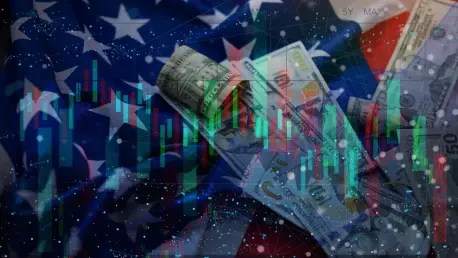As the U.S. economy navigates through the early months of 2025, a palpable sense of anticipation surrounds the Federal Reserve’s potential decision to cut interest rates, a move that could fundamentally alter the financial terrain for businesses and consumers alike. Fed Chair Jerome Powell’s recent remarks at the Jackson Hole Economic Symposium have ignited speculation about a possible rate reduction as early as September, driven by a noticeable shift in focus toward labor market stability over inflation control. This potential policy pivot arrives at a time when markets are already grappling with volatility, political uncertainties, and shifting consumer trends, making the stakes extraordinarily high. The implications of such a decision extend far beyond Wall Street, touching everything from mortgage rates to tech investments, and even everyday household budgets. With critical economic data on the horizon, the central question looms: will these anticipated rate cuts be the defining force in sculpting the economic environment for the remainder of 2025? This exploration aims to unpack the intricate web of factors at play, from Fed strategies to external pressures, offering a clear lens on what might lie ahead.
Shifting Fed Priorities: Labor Over Inflation
The Federal Reserve’s apparent readiness to prioritize labor market health over stringent inflation control marks a notable departure from its traditional stance, sparking intense discussion among analysts and investors. Powell’s comments at Jackson Hole underscored a growing concern for softening employment data, suggesting that the Fed might lower rates to bolster job growth even if inflation remains slightly elevated. This dovish tilt has fueled market expectations for a rate cut in the near term, with many eyeing September as a pivotal moment. Yet, this shift is not without complexity, as balancing economic growth with price stability remains a delicate act. The Fed’s challenge lies in interpreting upcoming data to ensure that any rate adjustment supports sustainable employment without reigniting inflationary pressures, a concern echoed by cautious voices within financial circles.
Market reactions to these signals have been swift but uneven, reflecting both optimism and apprehension about the Fed’s direction. The Dow Jones Industrial Average and S&P 500 have seen record highs on the heels of Powell’s remarks, only to experience sharp pullbacks as investors reassess the broader implications. Such volatility highlights the fragile confidence in the market, where hope for lower borrowing costs clashes with fears of policy missteps. If the Fed proceeds with rate cuts, the impact could ripple through sectors reliant on financing, potentially stimulating growth but also risking over-leveraging in an already uncertain environment. The coming weeks of economic reports will be crucial in determining whether these expectations hold or if the Fed opts for a more measured approach.
Political Dynamics Stirring Market Uncertainty
Beyond the realm of monetary policy, political developments are casting a significant shadow over economic forecasts, adding layers of unpredictability to the Fed’s potential actions. Former President Donald Trump’s vocal criticism of Fed officials and proposals for tariffs and government stakes in key industries like technology have triggered immediate market responses. For instance, retail stocks have taken hits following tariff announcements, while companies such as Intel have benefited from strategic government investments. These interventions underscore how political rhetoric can sway investor sentiment almost as powerfully as economic data, creating a dual narrative that the Fed must navigate. The interplay between policy proposals and market stability remains a critical factor to watch as 2025 progresses.
This political influence introduces a unique form of volatility that could either complement or undermine the effects of any rate cuts. When government actions directly impact specific sectors, as seen with tariff-related declines in furniture retail stocks, the broader market often reacts with heightened sensitivity, amplifying fluctuations in indices like the Nasdaq. This dynamic suggests that even if the Fed lowers rates to spur growth, political decisions could offset gains or exacerbate downturns in targeted industries. The uncertainty surrounding such external forces complicates the central bank’s ability to predict outcomes, making it imperative for policymakers to account for these variables when calibrating their approach to interest rates in the months ahead.
Market Swings and Sector-Specific Impacts
Financial markets have become a barometer of the uncertainty surrounding potential Fed rate cuts, with major indices displaying a pattern of dramatic swings that mirror investor sentiment. The Dow, S&P 500, and Nasdaq have all recorded impressive peaks following dovish Fed signals, only to retreat as doubts about the sustainability of such optimism creep in. These fluctuations are not merely reactions to policy speculation but also reflect broader concerns about global economic conditions and domestic challenges. Lower interest rates could ease borrowing costs and fuel investment, yet the current market behavior suggests a hesitancy to fully embrace this possibility without concrete data confirming the Fed’s next steps. This push-and-pull dynamic illustrates the high stakes tied to monetary policy decisions.
Sector-specific trends, particularly in technology, further complicate the picture as the Fed contemplates rate adjustments. The tech industry, driven by the AI boom and companies like Nvidia, remains a focal point of market enthusiasm, with upcoming earnings reports viewed as a litmus test for the sector’s valuation. Meanwhile, Intel’s significant government-backed investments highlight both opportunity and structural challenges within the semiconductor space. A rate cut could accelerate growth in tech by reducing capital costs, but lingering fears of overvaluation and external dependencies temper expectations. These contrasting forces within key industries underscore the uneven impact that Fed policy might have, necessitating a nuanced understanding of how different sectors stand to gain or struggle.
Ground-Level Economic Pressures and Consumer Trends
While high-level market dynamics and policy debates dominate headlines, ground-level economic indicators offer critical insights into the broader context in which Fed rate cuts might unfold. Consumer behavior shifts, such as a reported decline in alcohol consumption affecting beverage companies, signal potential caution or changing cultural norms that could dampen spending in certain areas. Similarly, intense rental competition in urban hubs like San Francisco points to persistent affordability issues, which could constrain household budgets despite any relief from lower interest rates. These micro-level trends are vital for the Fed to consider, as they reflect the real-world challenges that monetary policy must address beyond abstract market indices.
Another dimension of consumer impact lies in the housing market, where mortgage rates at their lowest in 2025 present both opportunities and hurdles. While reduced rates could stimulate demand for home purchases, ongoing affordability crises in competitive markets may limit the benefits for many Americans. This tension between potential growth and structural barriers highlights the complexity of translating Fed policy into tangible economic relief. If rate cuts materialize, their success in bolstering consumer confidence and spending will depend on how well they align with these underlying pressures. Policymakers must weigh these everyday realities alongside broader financial signals to craft a strategy that supports sustainable growth across all levels of the economy.
Navigating the Path Forward: Strategic Considerations
Reflecting on the multifaceted economic landscape of early 2025, it becomes clear that the Federal Reserve’s potential rate cuts have emerged as a central force influencing market sentiment and policy discourse. The shift toward labor market support, coupled with volatile market reactions, paints a picture of cautious optimism tempered by significant risks. Political interventions have added an unpredictable layer, with actions and rhetoric from figures like former President Trump directly swaying sector outcomes and investor confidence. Meanwhile, consumer trends and housing challenges have revealed the deeper economic undercurrents that any policy shift needs to address.
Looking ahead, the focus should shift to strategic preparation for the outcomes of these potential rate cuts, whether they materialize in September or later. Businesses and investors are advised to closely monitor upcoming economic data, as it holds the key to confirming the Fed’s direction. Policymakers, on the other hand, face the task of balancing labor support with inflation control, ensuring that any rate adjustments do not destabilize long-term growth. For consumers, staying informed about mortgage trends and spending impacts remains essential to navigating potential shifts. Ultimately, the collaborative effort between the Fed, political leaders, and market participants to adapt to these evolving dynamics stands as the cornerstone for shaping a resilient economic future.









